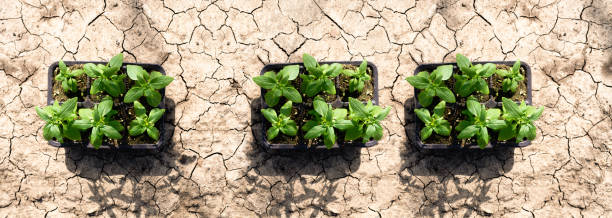
Climate change is having a dramatic effect on the agricultural industry, and its repercussions can be felt far beyond the fields. Farmers’ incomes have been particularly affected by the changing climate, leading to increased insecurity and instability in rural communities. In this blog post, we will discuss the impacts of climate change on farmers’ income, and what can be done to mitigate these effects.
The Changing Climate Landscape for Farmers
As the Earth’s climate continues to evolve, farmers are facing a changing landscape that presents numerous challenges. The impacts of climate change are being felt across the globe, with rising temperatures, unpredictable weather patterns, and extreme events becoming the new norm. These changes are not only affecting the livelihoods of farmers, but also the stability of rural communities.
One of the most significant ways in which climate change is impacting farmers is through rising temperatures. Heatwaves have become more frequent and intense, leading to droughts and water scarcity in many agricultural regions. This can have devastating effects on crop production, as plants need water to grow and thrive. Without access to sufficient water, farmers may experience reduced crop yields or even total crop failure.
In addition to the impact of rising temperatures, climate change is also causing shifts in precipitation patterns. Some regions are experiencing heavier rainfall and increased flooding, while others are facing prolonged periods of drought. These changes make it difficult for farmers to plan and manage their crops effectively. It becomes challenging to determine when to plant, irrigate, or harvest, leading to uncertainty and increased risk for farmers.
Furthermore, extreme weather events such as hurricanes, tornadoes, and wildfires are becoming more frequent and severe due to climate change. These events can cause significant damage to crops, livestock, and infrastructure, resulting in financial losses for farmers.
Overall, the changing climate landscape presents numerous challenges for farmers, affecting their income and the overall stability of rural communities. Adapting to these changes is crucial for the survival of the agricultural industry. In the following sections, we will explore in more detail the specific impacts of climate change on farmers’ income and discuss potential solutions to mitigate these effects.

Rising Temperatures and Climate Change
Climate change is not only increasing global temperatures, but also wreaking havoc on farmers’ livelihoods. Rising temperatures have become a key concern for agricultural communities, as they directly impact crop yields and overall farm productivity. With heatwaves becoming more frequent and intense, many regions are experiencing droughts and water scarcity, leading to reduced crop yields or even complete crop failure.
When temperatures soar, plants need more water to survive. But with water becoming scarce, farmers face the challenging task of managing their water resources effectively. Without access to sufficient water, crops suffer, and farmers’ incomes take a hit. This not only affects individual farmers, but also the stability of rural communities, as agricultural economies rely heavily on crop yields.
Another consequence of rising temperatures is the increased risk of pests and diseases. In warmer climates, pests thrive, causing damage to crops and further reducing yields. This leads to additional financial losses for farmers who are already grappling with the impacts of climate change.
Moreover, extreme heat poses risks to livestock as well. Heat stress can result in reduced fertility and weight loss, impacting the overall productivity and profitability of livestock operations. This puts additional strain on farmers’ income and can destabilize rural communities that depend on livestock production.
As the temperatures continue to rise, farmers face an uphill battle to adapt and mitigate the effects of climate change. It is crucial to implement sustainable farming practices and invest in technologies that help conserve water and reduce heat stress. Collaborative efforts between farmers, researchers, and policymakers are essential to finding innovative solutions to combat rising temperatures and protect farmers’ income. The agricultural industry must come together to face the challenges ahead and build resilience in the face of a changing climate.

Decreased Crop Yields and Livestock Production
The impacts of climate change on farmers go far beyond the changing weather patterns and rising temperatures. One of the most significant consequences is the decreased crop yields and livestock production that farmers are facing. As the climate continues to evolve, farmers are finding it increasingly challenging to grow crops and raise livestock successfully.
The changing climate has disrupted the delicate balance that farmers rely on to cultivate their fields and raise healthy livestock. Extreme weather events, such as droughts and floods, are becoming more frequent and intense, causing significant damage to crops and livestock. These events can wipe out entire harvests and devastate the livelihoods of farmers.
Additionally, the changing climate is leading to shifts in the availability of water, which is crucial for crop growth and livestock hydration. Droughts and water scarcity make it difficult for farmers to maintain healthy crops and keep their livestock well-nourished. This leads to reduced crop yields and lower productivity in livestock operations, ultimately impacting farmers’ income.
Furthermore, changing climate conditions also affect the timing and length of growing seasons, further reducing crop yields. As temperatures fluctuate and rainfall patterns become more unpredictable, farmers struggle to determine the optimal planting and harvesting times. This uncertainty can lead to suboptimal crop growth and lower yields.
The consequences of decreased crop yields and livestock production are profound. Farmers face financial losses, increased instability in rural communities, and potential food insecurity. To mitigate these impacts, farmers must adapt their farming practices and implement strategies that help conserve water, improve soil health, and protect crops and livestock from extreme weather events.
In the next sections, we will explore the rising production costs for farmers and the challenges they face in adapting to climate change. Additionally, we will discuss potential solutions to mitigate the impact on farmers’ income and build resilience in the face of a changing climate.

Rising Production Costs for Farmers
The impacts of climate change on farmers extend far beyond the fields and livestock pens. One major consequence that farmers face is the rising production costs associated with adapting to the changing climate. As temperatures rise and extreme weather events become more frequent, farmers are forced to invest more in protective measures, equipment, and resources to safeguard their crops and livestock.
Firstly, farmers need to invest in irrigation systems and water management practices to combat drought and water scarcity. This means purchasing and maintaining irrigation equipment, digging wells, and implementing water conservation strategies. These investments can be costly and put a strain on farmers’ budgets, especially for small-scale operations.
Additionally, extreme weather events such as storms, hurricanes, and wildfires can cause significant damage to crops and infrastructure. As a result, farmers often need to invest in improved storage facilities, protective structures, and insurance coverage to mitigate potential losses. These expenses further contribute to the rising production costs for farmers.
Furthermore, as pests and diseases become more prevalent due to changing climate conditions, farmers need to invest in pest control measures and disease prevention strategies. This includes the purchase of pesticides, biosecurity measures, and regular monitoring of crops and livestock. These additional costs can significantly impact farmers’ income and profitability.
Rising production costs not only affect farmers’ income directly, but they also lead to increased food prices for consumers. As farmers need to cover their expenses, they often pass on these costs to consumers, making food less affordable for many.
Overall, the changing climate necessitates significant investments from farmers to adapt and mitigate the impacts. Finding ways to reduce production costs, such as through sustainable farming practices and government support programs, is essential to ensuring the viability and sustainability of agricultural communities.

Challenges with Adapting to Climate Change
Adapting to climate change presents a myriad of challenges for farmers. One of the primary challenges is the unpredictability of weather patterns. As climate change continues to disrupt the climate, farmers face difficulty in determining the optimal time to plant, irrigate, or harvest their crops. This uncertainty leads to increased risk and vulnerability, as farmers must make critical decisions without clear guidelines.
Another challenge farmers face is the need to adjust their farming practices to suit the changing conditions. This can require significant investment in new technologies, equipment, and training. For example, farmers may need to transition from traditional farming methods to more sustainable practices, such as implementing conservation agriculture or adopting precision farming techniques. However, these changes come with a cost, and not all farmers have the financial means or access to resources to make these necessary adjustments.
Additionally, adapting to climate change often requires farmers to have access to accurate and timely information about weather patterns, market trends, and innovative farming techniques. Unfortunately, not all farmers have the necessary resources or infrastructure to access this information. This information gap can further exacerbate the challenges farmers face in adapting to climate change.
Furthermore, there may be cultural or traditional practices that are deeply ingrained in farming communities, which can make it difficult to embrace new methods. Overcoming resistance to change and fostering a culture of adaptation and innovation is a significant challenge in itself.

Potential Solutions to Mitigate Impact on Farmers’ Income
As farmers grapple with the impacts of climate change on their income, it is essential to explore potential solutions to help mitigate these effects. Here are some strategies that can be implemented to support farmers and build resilience in the face of a changing climate.
- Diversification: Farmers can diversify their crops and livestock to reduce the risks associated with changing climate conditions. By planting a variety of crops that are resilient to heat, drought, or excessive rainfall, farmers can increase their chances of maintaining consistent yields. Additionally, diversifying livestock can help farmers adapt to shifting market demands and reduce the impacts of extreme weather events on their operations.
- Sustainable Farming Practices: Implementing sustainable farming practices can help conserve water, improve soil health, and reduce greenhouse gas emissions. Techniques such as conservation agriculture, agroforestry, and precision farming can enhance the efficiency of resource use, protect against erosion, and increase productivity. Investing in these practices can lead to long-term cost savings and improved resilience.
- Access to Technology and Information: Providing farmers with access to technologies, such as weather monitoring systems, precision irrigation tools, and crop modeling software, can empower them to make informed decisions about their farming operations. Additionally, ensuring that farmers have access to accurate and timely information about weather patterns, market trends, and innovative farming techniques can help them adapt and thrive in a changing climate.
- Financial Support and Insurance: Governments and organizations can offer financial support and insurance programs to help farmers cope with the increased risks and uncertainties brought about by climate change. These programs can provide assistance for investments in infrastructure, equipment, and technologies, as well as compensate for crop losses or damages caused by extreme weather events.
- Collaboration and Knowledge Sharing: Encouraging collaboration between farmers, researchers, policymakers, and industry experts is crucial for finding innovative solutions to the challenges posed by climate change. Knowledge sharing platforms, farmer networks, and research partnerships can facilitate the exchange of ideas, best practices, and lessons learned, ultimately benefiting farmers and rural communities.
By implementing these potential solutions, farmers can begin to mitigate the impact of climate change on their income and build resilience in their operations. The collective effort of all stakeholders involved in the agricultural industry is crucial to ensuring a sustainable and prosperous future for farmers in a changing climate.

Conclusion
In this blog post, we have explored the far-reaching impacts of climate change on farmers’ income and the agricultural industry as a whole. The changing climate landscape, characterized by rising temperatures, unpredictable weather patterns, and extreme events, has created numerous challenges for farmers around the world.
One of the primary ways in which climate change is affecting farmers is through the decreased crop yields and livestock production. Droughts, floods, and shifts in precipitation patterns have disrupted the delicate balance that farmers rely on to cultivate their fields and raise healthy livestock. This has led to reduced crop yields, lower productivity in livestock operations, and financial losses for farmers.
Additionally, farmers face rising production costs as they invest in protective measures, equipment, and resources to adapt to the changing climate. The need for irrigation systems, improved storage facilities, pest control measures, and disease prevention strategies all contribute to the financial strain on farmers.
Adapting to climate change presents significant challenges for farmers, including the unpredictability of weather patterns, the need to adjust farming practices, and the cultural resistance to change. However, by implementing strategies such as diversification, sustainable farming practices, access to technology and information, financial support and insurance, and collaboration and knowledge sharing, farmers can mitigate the impact on their income and build resilience in their operations.
In conclusion, the impacts of climate change on farmers’ income are extensive and require immediate action. It is crucial for stakeholders in the agricultural industry, including farmers, researchers, policymakers, and industry experts, to work together to find innovative solutions. By taking proactive measures and supporting farmers in their adaptation efforts, we can ensure a sustainable and prosperous future for agriculture in a changing climate.






👍❤
Sir how can I help the farmers in life?
I was suggested this blog by my cousin. I’m now not certain whether or not this put up is written by him as no one else recognise such precise approximately my problem. You’re amazing! Thank you!
Merely a smiling visitor here to share the love (:, btw great design.
you’re truly a excellent webmaster. The site loading speed is incredible. It seems that you are doing any unique trick. Furthermore, The contents are masterwork. you have performed a wonderful job in this topic!
Spot on with this write-up, I really assume this web site needs much more consideration. I’ll most likely be once more to learn far more, thanks for that info.
I am perpetually thought about this, thankyou for posting.
I¦ve been exploring for a little for any high-quality articles or weblog posts in this kind of space . Exploring in Yahoo I finally stumbled upon this site. Studying this info So i¦m satisfied to convey that I’ve an incredibly good uncanny feeling I discovered exactly what I needed. I most without a doubt will make sure to do not overlook this website and give it a look on a continuing basis.
The next time I learn a blog, I hope that it doesnt disappoint me as much as this one. I imply, I know it was my choice to read, however I really thought youd have one thing interesting to say. All I hear is a bunch of whining about one thing that you can repair when you werent too busy looking for attention.
Well I sincerely enjoyed reading it. This post offered by you is very useful for good planning.
“Come si prende Reduslim” ist eine häufig gestellte Frage von Menschen, die auf der Suche nach einem natürlichen und effektiven Weg
zur Gewichtsabnahme sind. Es ist wichtig zu wissen, dass Reduslim ein Nahrungsergänzungsmittel ist, das bei der Gewichtsabnahme helfen kann, aber keine Wundermittel sind.
Um Reduslim effektiv zu nehmen, sollten die Anweisungen auf der Verpackung genau befolgt werden. Die empfohlene Dosierung beträgt in der
Regel zwei Kapseln pro Tag, vorzugsweise vor den Mahlzeiten. Es
ist wichtig, Reduslim regelmäßig einzunehmen und mit einer gesunden Ernährung und
ausreichender körperlicher Bewegung zu kombinieren.
Es ist auch wichtig, sich bewusst zu machen, dass Reduslim keine langfristige Lösung für Gewichtsprobleme ist.
Es sollte als Teil eines gesunden Lebensstils betrachtet
werden. Konsultieren Sie immer einen Arzt, bevor Sie ein Nahrungsergänzungsmittel einnehmen, um sicherzustellen, dass es
für Ihre individuellen Bedürfnisse geeignet ist.
Insgesamt kann Reduslim eine nützliche Ergänzung zu einer gesunden Ernährung und
Lebensweise sein, um beim Abnehmen zu helfen.
Durch die Beachtung der Dosierungsempfehlungen und die Kombination mit gesunden Gewohnheiten können positive
Ergebnisse erzielt werden. Denken Sie jedoch daran, dass nachhaltige
Veränderungen im Lebensstil der Schlüssel zu langfristigem Erfolg bei der Gewichtsabnahme sind.
Stop by my web site :: reduslim apotheke preis
https://gogocasino.one
The very root of your writing while sounding agreeable at first, did not settle perfectly with me personally after some time. Somewhere within the sentences you managed to make me a believer unfortunately just for a short while. I still have a problem with your leaps in logic and one would do well to help fill in those gaps. If you actually can accomplish that, I will certainly end up being fascinated.
Hiya, I am really glad I have found this information. Nowadays bloggers publish just about gossips and web and this is actually annoying. A good blog with exciting content, this is what I need. Thanks for keeping this website, I’ll be visiting it. Do you do newsletters? Can not find it.
About Blue Tonic Weight Loss Drink Recipe:The Blue Tonic Weight Loss Drink Recipe is more than just a beverage; it’s a potent blend of carefully selected ingredients designed to support your weight loss journey.
I’m also writing to make you understand what a incredible encounter my friend’s child enjoyed studying yuor web blog. She even learned too many things, most notably what it is like to possess an ideal teaching nature to have the others clearly grasp specified specialized subject matter. You truly did more than people’s expected results. Thanks for delivering such useful, healthy, informative and in addition fun thoughts on the topic to Sandra.
But wanna remark on few general things, The website pattern is perfect, the articles is rattling good : D.
Hello there! This is kind of off topic but I need some guidance from an established blog. Is it very hard to set up your own blog? I’m not very techincal but I can figure things out pretty quick. I’m thinking about creating my own but I’m not sure where to begin. Do you have any points or suggestions? Appreciate it
A powerful share, I simply given this onto a colleague who was doing slightly analysis on this. And he the truth is purchased me breakfast because I found it for him.. smile. So let me reword that: Thnx for the treat! But yeah Thnkx for spending the time to discuss this, I really feel strongly about it and love reading extra on this topic. If attainable, as you become expertise, would you mind updating your blog with more particulars? It’s extremely useful for me. Massive thumb up for this blog submit!
Very well written story. It will be valuable to anybody who utilizes it, including yours truly :). Keep doing what you are doing – can’r wait to read more posts.